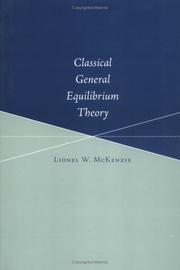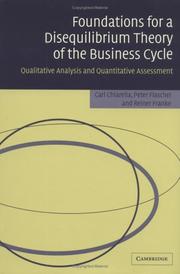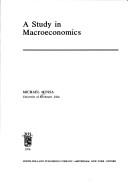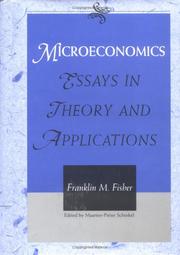| Listing 1 - 10 of 238 | << page >> |
Sort by
|

ISBN: 0415654866 0203799968 128005283X 0203694090 0415700019 0429234902 1135997381 9780203799963 0203682289 9780203682289 9786610052837 6610052832 9780415700016 9781135997380 9781135997335 9781135997373 9780415654869 1135997373 Year: 2004 Publisher: London ; New York : Routledge,
Abstract | Keywords | Export | Availability | Bookmark
 Loading...
Loading...Choose an application
- Reference Manager
- EndNote
- RefWorks (Direct export to RefWorks)
This book, as the title suggests, explains how General equilibrium, the dominant conceptual framework in mainstream economics, describes a perfectly impossible world. Even with its counterfactual assumptions taken for granted, it fails on many levels. Under the impressive editorship of Ackerman and Nadal, this book will appeal to students and researchers in economics and related social science disciplines.
Equilibrium (Economics) --- Economics --- Disequilibrium (Economics) --- Economic equilibrium --- General equilibrium (Economics) --- Partial equilibrium (Economics) --- DGE (Economics) --- DSGE (Economics) --- Dynamic stochastic general equilibrium (Economics) --- SDGE (Economic theory) --- Statics and dynamics (Social sciences)

ISBN: 0415296919 9786610289868 113443362X 0203217616 1280289864 0415863082 0203294432 9780203217610 0203273303 9780203273302 9780415296915 9781134433629 9781134433575 1134433573 9781134433612 1134433611 9780415863087 6610289867 9781280289866 Year: 2003 Publisher: London : Routledge,
Abstract | Keywords | Export | Availability | Bookmark
 Loading...
Loading...Choose an application
- Reference Manager
- EndNote
- RefWorks (Direct export to RefWorks)
Equilibrium (Economics) --- Economics. --- Economic theory --- Political economy --- Social sciences --- Economic man --- DGE (Economics) --- Disequilibrium (Economics) --- DSGE (Economics) --- Dynamic stochastic general equilibrium (Economics) --- Economic equilibrium --- General equilibrium (Economics) --- Partial equilibrium (Economics) --- SDGE (Economic theory) --- Economics --- Statics and dynamics (Social sciences)

ISBN: 0585436819 0262279525 9780262279529 9780585436814 9780262134132 0262134136 Year: 2002 Publisher: Cambridge, Mass. : MIT Press,
Abstract | Keywords | Export | Availability | Bookmark
 Loading...
Loading...Choose an application
- Reference Manager
- EndNote
- RefWorks (Direct export to RefWorks)
Although general equilibrium theory originated in the late nineteenth century, modern elaboration and development of the theory began only in the 1930s and 1940s. This book focuses on the version of the theory developed in the second half of the twentieth century, referred to by Lionel McKenzie as the classical general equilibrium theory. McKenzie offers detailed and rigorous treatment of the classical model, giving step-by-step proofs of the basic theorems. In many cases he elaborates on the individual steps to give a fuller understanding of the underlying principles. His goal is to provide readers with a true mastery of the methodology so that they can derive new results that will further enrich their thinking about general equilibrium theory. Special attention is given to the McKenzie model, in which it is not assumed that the number of firms is given but rather that technologies or activities are available to any agents who can supply the resources they require. The McKenzie model is used to establish the turnpike theorems of optimal and competitive capital accumulation.
Business & Economics --- Economic Theory --- Equilibrium (Economics) --- History. --- ECONOMICS/Microeconomics --- DGE (Economics) --- Disequilibrium (Economics) --- DSGE (Economics) --- Dynamic stochastic general equilibrium (Economics) --- Economic equilibrium --- General equilibrium (Economics) --- Partial equilibrium (Economics) --- SDGE (Economic theory) --- Economics --- Statics and dynamics (Social sciences)
Book
ISBN: 0128139943 0128139935 9780128139943 9780128139936 Year: 2018 Publisher: London, United Kingdom : Academic Press, an imprint of Elsevier,
Abstract | Keywords | Export | Availability | Bookmark
 Loading...
Loading...Choose an application
- Reference Manager
- EndNote
- RefWorks (Direct export to RefWorks)
Economic Disturbances and Equilibrium in an Integrated Global Economy: Investment Insights and Policy Analysis helps readers develop a framework for analyzing economic events and make better, more consistent decisions. Victor Canto presents the theoretical building blocks that make up the overall framework, then expands the framework to tackle more complex problems, applying additional considerations to actual policy or investment issues. Drawing upon the most recent trends in monetary policy and international economics, the book offers sustained direct engagement with the main research question and makes innovative use of the simple concepts of supply and demand to illuminate modern finance literature. The book succeeds by highlighting the often-forgotten interconnectedness of different economic processes. How do we respond to a change in policy or an economic shock? Are all the expected changes to the general equilibrium consistent with each other? Helps readers build an intellectual framework that enables them to interpret articles in the financial press and policy decisions in a logical and consistent manner Differs from other books by eschewing partial equilibria analyses and instead providing a general equilibrium perspective useful for investors and policy makers Provides supporting data on a freely-accessible website so readers can test and replicate results
Equilibrium (Economics) --- DGE (Economics) --- Disequilibrium (Economics) --- DSGE (Economics) --- Dynamic stochastic general equilibrium (Economics) --- Economic equilibrium --- General equilibrium (Economics) --- Partial equilibrium (Economics) --- SDGE (Economic theory) --- Economics --- Statics and dynamics (Social sciences) --- Economic policy --- E-books

ISBN: 0262272814 0585133662 9780585133669 0262061910 9780262272810 Year: 1997 Publisher: Cambridge, Mass. : MIT Press,
Abstract | Keywords | Export | Availability | Bookmark
 Loading...
Loading...Choose an application
- Reference Manager
- EndNote
- RefWorks (Direct export to RefWorks)
Equilibrium (Economics) --- Econometrics. --- Econometrics --- Business & Economics --- Economic Theory --- Economics, Mathematical --- Statistics --- DGE (Economics) --- Disequilibrium (Economics) --- DSGE (Economics) --- Dynamic stochastic general equilibrium (Economics) --- Economic equilibrium --- General equilibrium (Economics) --- Partial equilibrium (Economics) --- SDGE (Economic theory) --- Economics --- Statics and dynamics (Social sciences)

ISBN: 9780511492402 9780521850254 9780521369923 0511132867 9780511132865 0511492405 0521850258 0521369924 1107153603 1281217948 9786611217945 0511200889 0511132549 0511311141 0511132328 Year: 2005 Publisher: Cambridge Cambridge University Press
Abstract | Keywords | Export | Availability | Bookmark
 Loading...
Loading...Choose an application
- Reference Manager
- EndNote
- RefWorks (Direct export to RefWorks)
Building on The Dynamics of Keynesian Monetary Growth by Chiarella and Flaschel (2000), this 2005 book is a key contribution to business cycle theory, setting out a disequilibrium approach with gradual adjustments of the key macroeconomic variables. Its analytic study of a deterministic model of economic activity, inflation and income distribution integrates elements in the tradition of Keynes, Metzler and Goodwin (KMG). After a qualitative analysis of the basic feedback mechanisms, the authors calibrate the KMG model to the stylized facts of the business cycle in the U.S. economy, and then undertake a detailed numerical investigation of the local and global dynamics generated by the model. Finally, topical issues in monetary policy are studied in small macromodels as well as for the KMG model by incorporating an estimated Taylor-type interest rate reaction function. The stability features of this enhanced model are also compared to those of the original KMG model.
Business cycles --- Equilibrium (Economics) --- DGE (Economics) --- Disequilibrium (Economics) --- DSGE (Economics) --- Dynamic stochastic general equilibrium (Economics) --- Economic equilibrium --- General equilibrium (Economics) --- Partial equilibrium (Economics) --- SDGE (Economic theory) --- Economics --- Statics and dynamics (Social sciences) --- Econometric models. --- Business, Economy and Management
Book
ISBN: 1108595693 1108697011 1108693067 1108482600 Year: 2019 Publisher: New York : Cambridge university press,
Abstract | Keywords | Export | Availability | Bookmark
 Loading...
Loading...Choose an application
- Reference Manager
- EndNote
- RefWorks (Direct export to RefWorks)
The birth and death of firms is one of the main features of the business cycle. Yet mainstream DGSE macroeconomic models mostly ignore this phenomenon, thereby excluding any potential impact of economic policy on the probability of the birth and death of firms. Those DGSE models that do allow for this phenomenon do so at the cost of drastic simplifications, which effectively rule out causal links between the strategic interaction of industrial firms and the macroeconomy. This innovative new book develops a bottom-up, agent-based framework that shows how strategic interactions at the level of oligopolistic firms, and even at the level of individuals, affect entire industrial sectors and the equilibrium of the macroeconomy. It will appeal to academic researchers and graduate students working in computational economics, agent-based modelling and econophysics, as well as mainstream economists interested in learning more about alternatives to DGSE models in macroeconomics.
Macroeconomics --- Mathematical models. --- Equilibrium (Economics) --- DGE (Economics) --- Disequilibrium (Economics) --- DSGE (Economics) --- Dynamic stochastic general equilibrium (Economics) --- Economic equilibrium --- General equilibrium (Economics) --- Partial equilibrium (Economics) --- SDGE (Economic theory) --- Economics --- Statics and dynamics (Social sciences)

ISBN: 0521563240 0521118883 0511628471 9780521563246 9780511628474 9780521118880 Year: 1996 Publisher: Cambridge Cambridge University Press
Abstract | Keywords | Export | Availability | Bookmark
 Loading...
Loading...Choose an application
- Reference Manager
- EndNote
- RefWorks (Direct export to RefWorks)
This book brings together in a single coherent framework a research programme begun by the author in the forties. The main model around which the analysis is built is Hicksian in character, having been drawn in large part from John Hicks's Value and Capital. The model is extended so as to include money and securities. In respect of the theory of the firm the model focuses on demand and supply plans, on inputs and outputs, on inventories, and on dependencies between them. The stability of temporary equilibrium is discussed for linear and non-linear cases. Because the concept of structural stability is important for understanding non-linear cases, it is defined and applied to the case of economic motion generated from the temporary equilibrium analysis. The addenda focus on developments in economic theory following the publication of the main model.
Quantitative methods (economics) --- Equilibrium (Economics) --- Statics and dynamics (Social sciences) --- 339.0724 --- Disequilibrium (Economics) --- Economic equilibrium --- General equilibrium (Economics) --- Partial equilibrium (Economics) --- Economics --- Stagnation (Economics) --- Dynamics and statics (Social sciences) --- Equilibrium (Social sciences) --- Social evolution --- Social sciences --- Sociology --- Business, Economy and Management --- DGE (Economics) --- DSGE (Economics) --- Dynamic stochastic general equilibrium (Economics) --- SDGE (Economic theory) --- ECONOMICS --- EQUILIBRIUM (PHYSICS) --- STATICS AND DYNAMICS --- EQUILIBRIUM

ISBN: 0720404053 9780720404050 Year: 1976 Volume: 3 Publisher: Amsterdam : New York : North-Holland Pub. Co. ; distributors for the U.S.A. and Canada, Elsevier/North Holland,
Abstract | Keywords | Export | Availability | Bookmark
 Loading...
Loading...Choose an application
- Reference Manager
- EndNote
- RefWorks (Direct export to RefWorks)
Macroeconomics --- Equilibrium (Economics) --- 330.115 --- 330.101 --- Economics --- Disequilibrium (Economics) --- Economic equilibrium --- General equilibrium (Economics) --- Partial equilibrium (Economics) --- Stagnation (Economics) --- Statics and dynamics (Social sciences) --- Econometrie --- Economische analyse. Economische methodologie. Economische onderzoeksmethoden--(theoretische economie) --- 330.101 Economische analyse. Economische methodologie. Economische onderzoeksmethoden--(theoretische economie) --- 330.115 Econometrie --- DGE (Economics) --- DSGE (Economics) --- Dynamic stochastic general equilibrium (Economics) --- SDGE (Economic theory) --- Equilibrium (Economics). --- Macroeconomics.

ISBN: 0521624231 0521023297 0511572182 9780521624237 9780511572180 9780521023290 Year: 1999 Publisher: Cambridge Cambridge University Press
Abstract | Keywords | Export | Availability | Bookmark
 Loading...
Loading...Choose an application
- Reference Manager
- EndNote
- RefWorks (Direct export to RefWorks)
This book, the fourth volume of Franklin M. Fisher's collected articles, contains work in microeconomics stretching over four decades. Principal sections include essays on stability and disequilibrium, welfare economics and consumer theory, and applications of microeconomics. Topics include the decision whether or not to use statistical methods to adjust the census, and the economics of water in the Middle East as well as the effect of computer reservations systems on airlines and the theory of united fund drives by charities. An autobiographical essay serves as an epilogue.
Microeconomics --- Microeconomics. --- Equilibrium (Economics) --- Welfare economics. --- Economics. --- Business, Economy and Management --- Economics --- Economic theory --- Political economy --- Social sciences --- Economic man --- Economic policy --- Social policy --- DGE (Economics) --- Disequilibrium (Economics) --- DSGE (Economics) --- Dynamic stochastic general equilibrium (Economics) --- Economic equilibrium --- General equilibrium (Economics) --- Partial equilibrium (Economics) --- SDGE (Economic theory) --- Statics and dynamics (Social sciences) --- Price theory
| Listing 1 - 10 of 238 | << page >> |
Sort by
|

 Search
Search Feedback
Feedback About UniCat
About UniCat  Help
Help News
News